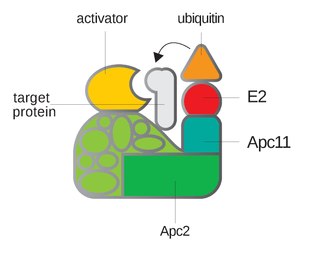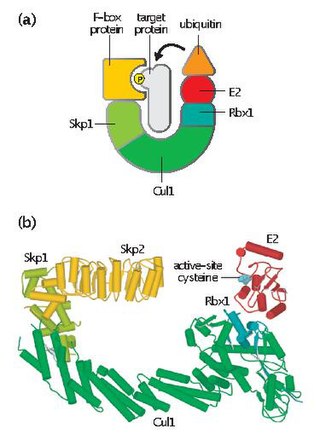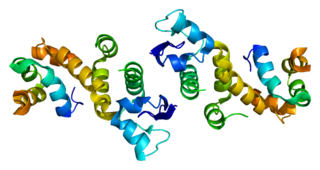
Ubiquitin is a small regulatory protein found in most tissues of eukaryotic organisms, i.e., it is found ubiquitously. It was discovered in 1975 by Gideon Goldstein and further characterized throughout the late 1970s and 1980s. Four genes in the human genome code for ubiquitin: UBB, UBC, UBA52 and RPS27A.

Anaphase-promoting complex is an E3 ubiquitin ligase that marks target cell cycle proteins for degradation by the 26S proteasome. The APC/C is a large complex of 11–13 subunit proteins, including a cullin (Apc2) and RING (Apc11) subunit much like SCF. Other parts of the APC/C have unknown functions but are highly conserved.

A ubiquitin ligase is a protein that recruits an E2 ubiquitin-conjugating enzyme that has been loaded with ubiquitin, recognizes a protein substrate, and assists or directly catalyzes the transfer of ubiquitin from the E2 to the protein substrate. In simple and more general terms, the ligase enables movement of ubiquitin from a ubiquitin carrier to another thing by some mechanism. The ubiquitin, once it reaches its destination, ends up being attached by an isopeptide bond to a lysine residue, which is part of the target protein. E3 ligases interact with both the target protein and the E2 enzyme, and so impart substrate specificity to the E2. Commonly, E3s polyubiquitinate their substrate with Lys48-linked chains of ubiquitin, targeting the substrate for destruction by the proteasome. However, many other types of linkages are possible and alter a protein's activity, interactions, or localization. Ubiquitination by E3 ligases regulates diverse areas such as cell trafficking, DNA repair, and signaling and is of profound importance in cell biology. E3 ligases are also key players in cell cycle control, mediating the degradation of cyclins, as well as cyclin dependent kinase inhibitor proteins. The human genome encodes over 600 putative E3 ligases, allowing for tremendous diversity in substrates.

Skp, Cullin, F-box containing complex is a multi-protein E3 ubiquitin ligase complex that catalyzes the ubiquitination of proteins destined for 26S proteasomal degradation. Along with the anaphase-promoting complex, SCF has important roles in the ubiquitination of proteins involved in the cell cycle. The SCF complex also marks various other cellular proteins for destruction.

S-phase kinase-associated protein 2 is an enzyme that in humans is encoded by the SKP2 gene.

Cullin 1, also known as CUL1, is a human protein and gene from cullin family. This protein plays an important role in protein degradation and protein ubiquitination.

RING-box protein 1 is a protein that in humans is encoded by the RBX1 gene.

F-box/WD repeat-containing protein 1A (FBXW1A) also known as βTrCP1 or Fbxw1 or hsSlimb or pIkappaBalpha-E3 receptor subunit is a protein that in humans is encoded by the BTRC gene.

F-box/WD repeat-containing protein 7 is a protein that in humans is encoded by the FBXW7 gene.

CDC34 is a gene that in humans encodes the protein Ubiquitin-conjugating enzyme E2 R1. This protein is a member of the ubiquitin-conjugating enzyme family, which catalyzes the covalent attachment of ubiquitin to other proteins.

Cyclin-dependent kinases regulatory subunit 1 is a protein that in humans is encoded by the CKS1B gene.

βTrCP2 is a protein that in humans is encoded by the FBXW11 gene.

F-box only protein 4 is a protein that in humans is encoded by the FBXO4 gene.

F-box only protein 11 is a protein that in humans is encoded by the FBXO11 gene.

F-box/LRR-repeat protein 2 is a protein that in humans is encoded by the FBXL2 gene.

G2/mitotic-specific cyclin-F is a protein that in humans is encoded by the CCNF gene.

Cullins are a family of hydrophobic scaffold proteins which provide support for ubiquitin ligases (E3). All eukaryotes appear to have cullins. They combine with RING proteins to form Cullin-RING ubiquitin ligases (CRLs) that are highly diverse and play a role in myriad cellular processes, most notably protein degradation by ubiquitination.

S-phase kinase-associated protein 1 is an enzyme that in humans is encoded by the SKP1 gene.

Cdc4 is a substrate recognition component of the SCF ubiquitin ligase complex, which acts as a mediator of ubiquitin transfer to target proteins, leading to their subsequent degradation via the ubiquitin-proteasome pathway. Cdc4 targets primarily cell cycle regulators for proteolysis. It serves the function of an adaptor that brings target molecules to the core SCF complex. Cdc4 was originally identified in the model organism Saccharomyces cerevisiae. CDC4 gene function is required at G1/S and G2/M transitions during mitosis and at various stages during meiosis.

F-box protein 40 is a protein that in humans is encoded by the FBXO40 gene. Fbxo40 induces ubiquitination of IRS1, thus limiting activity of IGF1 signaling.




















